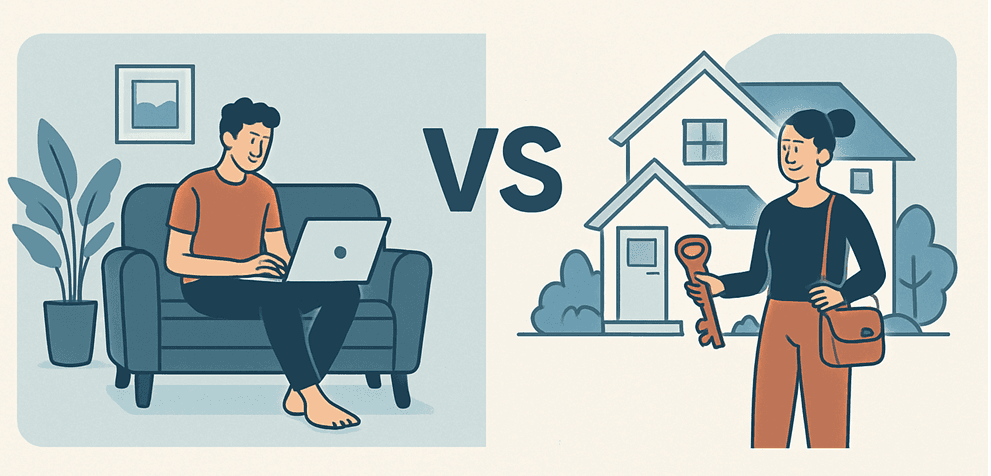Ask GRAI Anything
Your Real Estate Questions, Answered Instantly via Chat


Help us make GRAI even better by sharing your feature requests.

The Real Cost of Ownership, the Hidden ROI of Renting, and How GRAI Can Simulate the Right Move For You
In 2025, the question isn’t just ‘Should I rent or buy?’ - it’s ‘What will owning this property really cost me in time, freedom, and returns?’
Whether you’re a young professional, a digital nomad, or a first-time homebuyer, this choice is no longer straightforward. With interest rates still volatile, housing prices stabilizing in some areas (and skyrocketing in others), and remote work redefining mobility, the answer depends on more than spreadsheets - it depends on you.
Let’s break it down.
Owning property is still one of the strongest long-term wealth-building tools - if done right. But the assumptions of the past don’t always hold up in today’s economy.
Buying makes sense if:
You plan to stay in one place for 5–10+ years
You can afford at least 20% down (or more, in HNW markets)
The local market is expected to appreciate above inflation
You’ve modeled repair, tax, and opportunity cost scenarios (spoiler: most don’t)
Also Read: How U.S. High-Income Investors Use Real Estate Tax Strategies to Build Wealth Faster
But beware:
Mortgage rates may feel low vs 2023 highs, but they still eat into purchasing power
Taxes, HOA, maintenance, and closing costs quietly erode returns
Geographic lock-in can become a career constraint, especially for global professionals
With GRAI, you can model:
“Run 5-year ROI projection for a $700K condo in downtown Austin vs renting and investing the difference.”
“Simulate total cost of ownership in Singapore vs renting + ETF DCA strategy.”
Renting gets a bad rap. But in 2025, flexibility has a dollar value - and smart renters are investing the difference.
Renting makes sense if:
You’re globally mobile or expect career/life shifts
You prefer liquidity and lower maintenance stress
You’re investing savings consistently (vs spending them)
Strategic renters win when:
They avoid buying in overheated markets
They rent luxury at a discount vs buying mediocre
They redirect saved capital into global markets, REITs, or even income-generating crypto
With GRAI, you can model:
“Compare wealth after 10 years: renting in Berlin vs buying in Lisbon.”
“Simulate lifestyle-adjusted ROI of renting in Dubai vs owning a $1.1M villa.”
Also Read: AI Predictions for Lisbon Real Estate Market Trends 2025
Absolutely - if you treat renting as a strategy, not a default.
Here’s how:
Invest what you’d have put toward a down payment
Run your cash flow through compound growth simulations
Use GRAI to optimize capital deployment (e.g., global REITs, second-city rentals, or fractional CRE)
Renting = flexibility. GRAI = strategy.
Together, they beat uninformed ownership.
Zara, 32, digital strategist:
Salary: $115,000 (remote)
Cities considered: Dubai, Lisbon, Bali
Decision: Rent in Lisbon, invest in fractional Dubai retail + Bali off-plan
Must Read: Dubai Real Estate Market in 2025: The Ultimate Investor's Guide with GRAI
GRAI Simulation Result:
10-year blended portfolio IRR: 9.4%
Cost of renting: offset in 3.8 years by gains
ROI of flexibility: priceless (career promotion, global exposure)
Zara didn’t just rent. She multiplied.
The right question is: “Where will my money and life grow best in the next 3–10 years?”
GRAI isn’t just a calculator. It’s your AI investment partner, simulating:
Buy vs Rent across 100+ cities
Time-adjusted returns
FX impact for cross-border investors
Lifestyle costs (mobility, tax, insurance, etc.)
Run your simulation today: https://internationalreal.estate/chat
Make your move - backed by data, not default thinking.